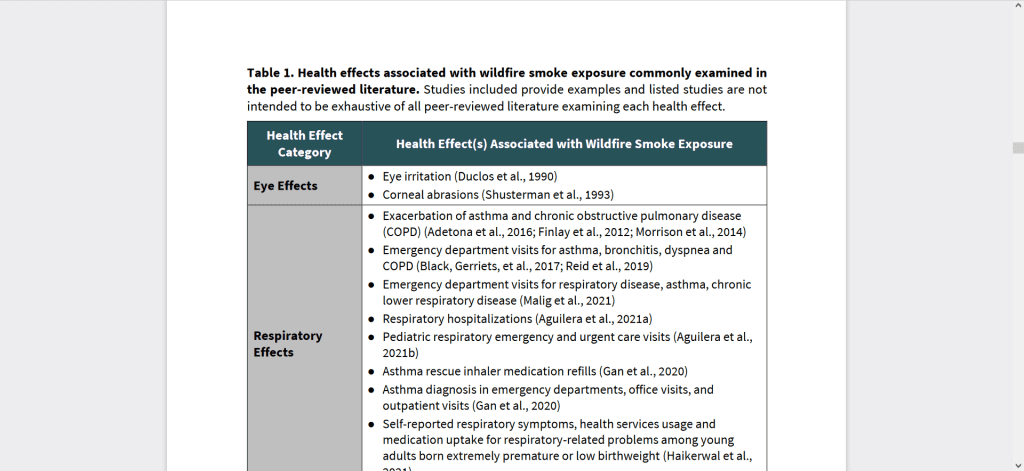Many thanks to Anonymous for linking to this paper comparing what is known about health effects from wildfire compared to prescribed fire smoke. I think it’s interesting how this recently became popular to study; it illustrates that absence of evidence was not evidence of absence. It was just a function of who is holding the science flashlight and funding. This study was funded by the American Lung Association. It also points to programs of interest to those who breath wildfire and prescribed fire smoke, which can be many of us as the summer sets in. It also makes us, of course, even more concerned about wildland firefighters’ exposure.
Here’s the prescribed fire part of the summary.
Page 6 | Summary
Prescribed fires are implemented under planned, predictable circumstances where additional measures can be taken to minimize exposures. While there are existing regulations, guidelines and long–term land management practices in place that aim to minimize the smoke impacts from prescribed fire, expanded prescribed fire activities should be coupled with additional policies and best practices to mitigate potential harmful smoke exposure. Effective prescribed fire policies and best practices should include consideration of: fuel type and loadings; ambient air quality levels; potential for air quality standard exceedances; proximity to residential communities and vulnerable populations; the availability of advanced warning and notification systems; more comprehensive air monitoring efforts; and forecasting tools for use in fire management planning. Additionally, future policies should encourage strategies to further mitigate potentially harmful impacts from prescribed fire smoke, such as: (1) improved prescribed fire management planning by conducting more air quality monitoring during burn activities and expanding prescribed fire reporting and public notification; (2) utilization and/or further development of tools to forecast potential prescribed fire impacts; and (3) implementation of interventions and other mitigation efforts that reduce exposures, such as portable air cleaners and residential heating, ventilation, and air conditioning (HVAC) systems, among others.
Further research is needed to evaluate comparative risks of prescribed fire smoke and wildfire. Research focused on the comparative health risks of prescribed fire and wildfire is currently very limited. Future research on the air quality and health impacts of biomass smoke should include an assessment of the health impacts from prescribed fire smoke.
The below is about “Smoke-Ready Communities” an EPA program:
The “Smoke–Ready Community” framework also provides a comprehensive approach to prepare communities for wildfire and ultimately reduce harms to public health and safety. As defined by the U.S. EPA, a Smoke–Ready Community is a community: (1) with public buildings equipped with filtration for fire smoke; (2) whose residents understand the health risks associated with smoke exposure and can readily access tools to protect their health; and (3) with available resources aimed to help those most vulnerable to smoke exposures (McGown, 2020; U.S. EPA, 2018).
Additionally, the U.S. EPA provides a “Smoke–Ready Toolbox” to prepare fire–prone communities for wildfire smoke events (U.S. EPA, 2018). This toolbox provides information, trainings and measures the public can use to understand and reduce potential health risks and reduce health impacts before, during, and after a wildfire event occurs (U.S. EPA, 2018). These include resources such as: online training for health care providers to better understand how wildfire smoke can impact their patients’ health; health and wildfire preparedness fact sheets, which provide information on how to reduce your smoke exposure, how to protect your
children, pets, and/or large animals from smoke and ash exposure, and indoor air filtration options, among others; information related to public notification systems and the best ways to stay informed during a wildfire event; and recommended supplies to take with you in the event of an evacuation (among others) (U.S. EPA, 2018). Measures identified within this toolbox can also be applied to help mitigate the impacts from prescribed fire events as well, and have been implemented in communities across the U.S., including in California, Oregon, and Washington (McGown, 2020; Troisi, 2021).
The below is only part of the table in the report..


I’ve often heard folks say, and perhaps write here, that “You can have a little smoke now or a lot of smoke later.”